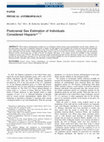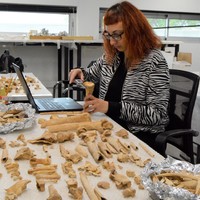Papers by Meredith Tise

Journal of Forensic Sciences, 2014
Population-specific reference data are necessary for sex estimation in forensic anthropological p... more Population-specific reference data are necessary for sex estimation in forensic anthropological practice. Currently, there are no population-specific data for Hispanics equivalent to data available for American Blacks and Whites. Individuals of Mexican origin represent the largest group of Hispanics in the United States (Spradley and Jantz. 2011. J Forensic Sci;56:289). This paper presents new population-specific sex estimation criteria for postcranial measurements for Mexican Hispanics. Metric data come from positively identified border-crossing fatalities at the Pima County Office of the Medical Examiner and documented cemetery collections curated at Universidad Nacional Aut onoma de M exico and Universidad Aut onoma de Yucat an. Stepwise variable selection procedures and discriminant function analyses were utilized to generate classification functions for postcrania. Sectioning points were also created for select measurements. Both the cross-validated classification rates and sectioning points achieved accuracy rates as high as 95% and 92%, respectively. These new criteria will improve sex estimation for US Mexico border crossers and Hispanics in the US.

The state of Florida is commonly ignored as a border state when it comes to issues and challenges... more The state of Florida is commonly ignored as a border state when it comes to issues and challenges in migrant death investigations. In the 2010 U.S. Census, Florida held the third largest Hispanic population in the United States, with almost 19 million individuals self-identifying as Hispanic, following behind California and Texas (Ennis et al. 2011). Undocumented workers that arrive in the United States frequently migrate to Florida for labor, such as on produce farms, and many of these workers are children, traveling alone, or under circumstances that make them an at-risk group. Endangered, missing, and unidentified persons in Florida are growing problems, with significant numbers of affected persons from the Caribbean, Mexico, and Central America. This research explores the variation among six diverse groups that are found in Florida and throughout the United States, especially along the border. These groups include four groups considered Hispanic (Mexico, Guatemala, Puerto Rico, ...

Population-specific reference data are necessary for sex estimation in forensic anthropological p... more Population-specific reference data are necessary for sex estimation in forensic anthropological practice. Currently, there are no population-specific data for Hispanics equivalent to data available for American Blacks and Whites. Individuals of Mexican origin represent the largest group of Hispanics in the United States (Spradley and Jantz. 2011. J Forensic Sci;56:289). This paper presents new population-specific sex estimation criteria for postcranial measurements for Mexican Hispanics. Metric data come from positively identified border-crossing fatalities at the Pima County Office of the Medical Examiner and documented cemetery collections curated at Universidad Nacional Aut onoma de M exico and Universidad Aut onoma de Yucat an. Stepwise variable selection procedures and discriminant function analyses were utilized to generate classification functions for postcrania. Sectioning points were also created for select measurements. Both the cross-validated classification rates and sectioning points achieved accuracy rates as high as 95% and 92%, respectively. These new criteria will improve sex estimation for US Mexico border crossers and Hispanics in the US.
Forensic Science International, 2014

The state of Florida is commonly ignored as a border state when it comes to issues and challenges... more The state of Florida is commonly ignored as a border state when it comes to issues and challenges in migrant death investigations. In the 2010 U.S. Census, Florida held the third largest Hispanic population in the United States, with almost 19 million individuals self-identifying as Hispanic, following behind California and Texas (Ennis et al. 2011). Undocumented
workers that arrive in the United States frequently migrate to Florida for labor, such as on produce farms, and many of these workers are children, traveling alone, or under circumstances
that make them an at-risk group. Endangered, missing, and unidentified persons in Florida are growing problems, with significant numbers of affected persons from the Caribbean, Mexico, and Central America. This research explores the variation among six diverse groups that are found in Florida and throughout the United States, especially along the border. These groups include four groups considered Hispanic (Mexico, Guatemala, Puerto Rico, and Cuba), as well as American white and black. Based on canonical discriminant function and Mahalanobis distance (D2) analyses, the Mexican and Guatemalan samples are the two most similar groups when comparing only the four groups considered Hispanic (D2 = 2.581) and among all six groups (D2 = 2.645). Within the four groups considered Hispanic, the Puerto Rican and Cuban samples are the second most similar groups (D2 = 4.690). However, when comparing all six groups, the Cuban and American black samples are the second most similar groups (D2 = 3.289). These results reflect a shift in similarities in cranial morphology when including the American black and white samples. By improving our understanding of the historical and current biological relationships among diverse groups living in close proximity, forensic anthropologists can better utilize ancestry data into their biological profiles for human identification.
Genetic research has documented geographical variation within Mexico that corresponds to trends i... more Genetic research has documented geographical variation within Mexico that corresponds to trends in ancestry admixture from postcolonial times on. The purpose of this study is to determine whether craniometric variation among contemporary Mexicans is comparable to that reported in genetic studies. Standard osteometric measurements were taken on 82 male crania derived from forensic cases, with geographic origins of the specimens spanning over two-thirds of Mexico's states. To study similarities in regional clustering patterns with genetic data, k-means clustering analyses were performed, followed by chi-square tests of association between cluster assignments and geographic region of origin. Normal mixtures analyses were performed, centered on three "ancestral" sample proxies to estimate classification probability to each ancestry. The results
jou r nal h o mep age: w ww.els evier .co m/lo c ate/fo r sc iin t http://dx.

When forensic anthropologists estimate the sex of Hispanic skeletal remains using nonpopulation s... more When forensic anthropologists estimate the sex of Hispanic skeletal remains using nonpopulation specific metric methods, initial observations cause males to frequently misclassify as female. To help improve these methods, this research uses postcranial measurements from United States–Mexico border migrant fatalities at the Pima County Office of the Medical Examiner in Tucson, Arizona, as well as Hispanic individuals from the Forensic Anthropology Data Bank. Using a total of 114 males and 28 females, sectioning points and discriminant functions provide classification rates as high as 89.43% for Hispanic individuals. A test sample assessed the reliability of these techniques resulting in accuracy up to 99.65%. The clavicle maximum length measurement provides the best univariate estimate of sex, while the radius provides the best multivariate estimated of sex. The results of this research highlight the need for population specific data in the creation of a biological profile, especially when working with individuals considered Hispanic.
Conference Presentations by Meredith Tise










Uploads
Papers by Meredith Tise
workers that arrive in the United States frequently migrate to Florida for labor, such as on produce farms, and many of these workers are children, traveling alone, or under circumstances
that make them an at-risk group. Endangered, missing, and unidentified persons in Florida are growing problems, with significant numbers of affected persons from the Caribbean, Mexico, and Central America. This research explores the variation among six diverse groups that are found in Florida and throughout the United States, especially along the border. These groups include four groups considered Hispanic (Mexico, Guatemala, Puerto Rico, and Cuba), as well as American white and black. Based on canonical discriminant function and Mahalanobis distance (D2) analyses, the Mexican and Guatemalan samples are the two most similar groups when comparing only the four groups considered Hispanic (D2 = 2.581) and among all six groups (D2 = 2.645). Within the four groups considered Hispanic, the Puerto Rican and Cuban samples are the second most similar groups (D2 = 4.690). However, when comparing all six groups, the Cuban and American black samples are the second most similar groups (D2 = 3.289). These results reflect a shift in similarities in cranial morphology when including the American black and white samples. By improving our understanding of the historical and current biological relationships among diverse groups living in close proximity, forensic anthropologists can better utilize ancestry data into their biological profiles for human identification.
Conference Presentations by Meredith Tise
workers that arrive in the United States frequently migrate to Florida for labor, such as on produce farms, and many of these workers are children, traveling alone, or under circumstances
that make them an at-risk group. Endangered, missing, and unidentified persons in Florida are growing problems, with significant numbers of affected persons from the Caribbean, Mexico, and Central America. This research explores the variation among six diverse groups that are found in Florida and throughout the United States, especially along the border. These groups include four groups considered Hispanic (Mexico, Guatemala, Puerto Rico, and Cuba), as well as American white and black. Based on canonical discriminant function and Mahalanobis distance (D2) analyses, the Mexican and Guatemalan samples are the two most similar groups when comparing only the four groups considered Hispanic (D2 = 2.581) and among all six groups (D2 = 2.645). Within the four groups considered Hispanic, the Puerto Rican and Cuban samples are the second most similar groups (D2 = 4.690). However, when comparing all six groups, the Cuban and American black samples are the second most similar groups (D2 = 3.289). These results reflect a shift in similarities in cranial morphology when including the American black and white samples. By improving our understanding of the historical and current biological relationships among diverse groups living in close proximity, forensic anthropologists can better utilize ancestry data into their biological profiles for human identification.